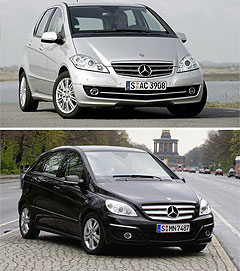Make / Model Search
News - Mercedes-BenzBaby Benz may go RWDTechnology sharing: BMW 1 Series could provide the basis of Mercedes' small cars in the generation after next. Mercedes and BMW are considering sharing a small car within the next decade8 Oct 2008 MERCEDES-BENZ is believed to be in discussions with arch-rival BMW for the development of a new range of rear-wheel-drive small cars to eventually slot beneath its highly successful C-class range. If the talks prove fruitful between Daimler AG and BMW AG, the result is expected to spawn the replacement for the front-drive A- and B-class small cars in the Mercedes-Benz model portfolio, as well as sire a future BMW 1 Series family. However, this would not likely occur before the middle of the next decade, as both companies’ replacements for their respective current small-car ranges are in their final development phases. Furthermore, reports indicate that talks between Mercedes and BMW are moving at a very slow rate, with many hurdles (as well as egos) for both sides to deal with. Nevertheless, whether the next-generation 1 Series due in around 2011 ends up playing host to the next baby Benz sometime down the line remains a tantalising possibility. “The volume of scale benefits, whether it be for axles, engines, gearboxes or other mechanical components, is enormous and would increase profitability,” remarked one Mercedes insider. In the meantime, a new front-drive version of the current W169 A/ 245-series B-class family is expected to be unveiled within the next two years. If a future Mercedes/BMW project does get the green light, a manufacturing site outside of Germany - where current versions of both the A/B-class and 1 Series are built – might serve as the ideal production source for the new project.  Left: Mercedes-Benz A-class and B-class. Left: Mercedes-Benz A-class and B-class.In June, Daimler AG announced that it would invest around €800 million ($A1.5 billion) in a new plant in Hungary, following news just a few weeks earlier of a €600 million ($A1.15 million) upgrade of its existing A/B-class plant in Rastatt, Germany. At the time, Mercedes-Benz chairman Dieter Zetsche said that the secret new model variants will “win additional target groups” for the Mercedes-Benz brand, adding weight that a departure from the current A/B-class format is on the cards. “Mercedes-Benz is going to offer an even wider range of exciting premium cars – with the high levels of comfort, safety and overall quality that are characteristic for the brand – in the particularly fuel-efficient compact-car segment,” Dr Zetsche said. “Moreover, our expanded product range will allow us to tap into new customer groups and open up new market regions.” BMW would also benefit from having a cheaper production base and shared development costs for future 1 Series models. The current car – which kicked off with the E87 hatch in 2004 – shares many components with today’s E90 3 Series, reflecting the premium pricing that the smallest BMW model commands. The next model will also be twinned with the next 3 Series, as well as the production version of the X1 SUV that starred at BMW’s Paris motor show stand, among other vehicles. But BMW is said to be looking at cutting costs, particularly as the credit crunch starts to severely impact revenues across the globe, so the replacement for this 2011 1 Series family will probably have to be a lot less expensive to build. BMW is already in small-car collaboration mode. In July it was reported that the next-generation Mini is to share its all-new platform with a model co-developed with the Fiat Group – namely an Alfa Romeo that is likely to be the future Mito that was recently announced. If the future small-car deal between Mercedes and BMW is struck, both vehicles are expected to share suspensions, engines and gearboxes, albeit in a different state of tune to reflect each brand’s unique characteristics. However, any collaboration between the two firms would definitely have to feature completely different body styles and interiors. Given the go-ahead, the Mercedes version is expected to come in hatchback, sedan and coupe configurations. Not only would this spell the end of the front-wheel drive Mercedes-Benz-badged passenger car, it may also sound the death knell for the innovative sandwich floor design of the current A/B-class. Dating back to the original W168 A-class of 1997, this unique structure was originally devised to provide a sub-cabin engine-intrusion path in the event of a severe frontal impact. Mercedes-Benz is also said to have thought about the possibility of using the space underneath the floor for alternative fuel drivetrains, as demonstrated by the myriad of hydrogen fuel cell A-class prototypes the company has developed over the last decade. However, this is an extremely expensive and impractical structure to build, as it cannot have applications beyond the small-car sphere. Mercedes-Benz is also reportedly dismayed at the inability of the A- and B-class to garner the same degree of critical acclaim that cheaper rivals such as the Volkswagen Golf and Ford Focus have achieved. Read more:Merc’s A to B to CDIBenz plans two new compact cars Electric BMW is on the table |
Click to shareMercedes-Benz articlesResearch Mercedes-Benz Motor industry news |









Facebook Twitter Instagram